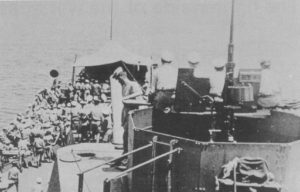- Author
- Thomson, Max
- Subjects
- History - WW2, Humour
- Tags
-
- RAN Ships
- HMAS Hawkesbury I
- Publication
- December 2005 edition of the Naval Historical Review (all rights reserved)
As movies, so many of the films screened to RAN personnel in rare moments of comparative leisure time in wartime ships were easily forgettable. For the author and many like him, it was perhaps the locations and especially the circumstances under which they were screened, that were gems of wartime naval lifestyle.

(Photo: NHSA Archives)
With ships and crews overworked and spending 25-28 days of each month at sea, a night spent in a fleet base with the chance of seeing a movie was a relished occasion. It exemplified too, the remarkable camaraderie of the day. The larger warships so readily extended invitations to crewmen from nearby small ships to join them and view a film – often sending off their own motor cutters to pick up men from neighbouring anchorages.
American generosity
This hospitality was at its zenith, too, with the generosity of the American warships. They not only invited our sailors but on so many occasions the RAN men returned to their own ships with generous quantities of reading matter, especially the small-print compact editions of the Armed Services books and novels.
Oro Bay on the New Guinea coastline provided a memorable example in the early days of General Douglas MacArthur’s island hopping campaigns. ML 817, a Fairmile type forerunner of today’s sleek RAN patrol vessels, was operating with USN torpedo boats along the New Guinea coast, harassing Japanese barge traffic and undertaking patrols, nightime surveillance operations and a variety of different assignments. A rare treat for its crew lay in an invitation to enjoy the classic James Cagney film “Yankee Doodle Dandy” onboard USS Hilo (formerly a millionaire’s enchanting yacht, seconded to the USN as a torpedo-boat mothership).
New Guinea highlights
New Guinea in those days provided other classic examples. RAN warships taking convoys into Port Moresby or on day and night anti-submarine patrols outside Moresby Harbour and its sea lane approaches occasionally put crews ashore to stretch their legs. A ride thumbed in an army truck saw a few sailors scattered among servicemen squatted on rocks and rubble on a hillside slope, to enjoy a film projected onto a hastily-erected canvas screen – usually interrupted by Japanese night attacks on Port Moresby.
Films in the rain
Milne Bay was equally dramatic. Renowned for its awful rain, the Gili Gili area was usually a sea of unbelievable mud and slush as heavy army trucks ploughed through it all, complete with bow wave left behind, so deep was the mire. Yet their drivers were ever anxious to give a lift to any sailor or serviceman out to where a film show was being screened, which, more often than not, had to be viewed in the rain.
A big American floating dock in Hollandia, in what was the Dutch New Guinea (now Indonesian Irian Jaya) provided an unusual venue for an RAN frigate’s men to enjoy “Babes on Swing Street” and the US fleet tanker USS Winooski hosted men from its RAN convoy escort to see “The Princess and the Pirate” amid memorable circumstances in the Philippines. “Manila Calling” seemed a so-appropriate film in Leyte Gulf (Philippines) for the Aussie sailors invited onboard the US attack transport La Salle.
HMAS Hawkesbury’s experiences
In Majuro Atoll (US Marshall Islands – now Kwajalein) HMAS Hawkesbury men got ashore to see “Atlantic City” in a classic jungle-clad setting. Back in Leyte Gulf fleet base they enjoyed “Footsteps in the Dark” onboard the destroyer USS Thomason and “George Washington Slept Here” onboard the fleet repair transport USS Henry T Allen. Later on USS Medusa (a depot ship) they were to see “White Savages” and “Canterville Ghosts”. Such a double-header with two films was a rare treat indeed.
Across at Macassar in the Celebes (Indonesia) in a town theatre not long taken over from the Japanese, the film “Dames” provided novelty, purely because of the setting and circumstances. In time our RAN ships in the forward areas had their own 16mm projectors and about the first signal exchanged when the mudhook hit bottom in any anchorage was in the form of a quest to swap a film with a nearby ship. With only one projector, usually screening on the quarterdeck, onto a screen erected on the sternrail, the good-humoured banter that flourished as one reel was taken off and the next threaded, often was more entertaining than the film itself.




